 |
|||||
| Home | Research | For Teachers | HISTORY Level 1 Level 2 Level 3 |
PRINCIPLES Level 1 Level 2 Level 3 |
CAREER Level 1 Level 2 Level 3 |
| Gallery | Hot Links | What's New! | |||
| Web Administration and Tools | |||||
 |
|||||
| Home | Research | For Teachers | HISTORY Level 1 Level 2 Level 3 |
PRINCIPLES Level 1 Level 2 Level 3 |
CAREER Level 1 Level 2 Level 3 |
| Gallery | Hot Links | What's New! | |||
| Web Administration and Tools | |||||
Rocket History
![]()
Today's rockets are remarkable collections of human ingenuity. NASA's Space Shuttle, for example, is one of the most complex flying machines ever invented. It stands upright on a launch pad, lifts off as a rocket, orbits Earth as a spacecraft, and returns to Earth as a gliding airplane. The Space Shuttle is a true spaceship. In a few years it will be joined by other spaceships. The European Space Agency is building the Hermes and Japan is building the HOPE. Still later may come aerospace planes that will take off from runways as airplanes, fly into space, and return as airplanes.
The rockets and spaceships of today and the spaceships of the future have their roots in the science and technology of the past. They are natural outgrowths of literally thousands of years of experimentation and research on rockets and rocket propulsion.
One of the first devices to successfully employ the principles essential to rocket flight was a wooden bird. In the writings of Aulus Gellius, a Roman, there is a story of a Greek named Archytas who lived in the city of Tarentum, now a part of southern Italy. Somewhere around the year 400 B.C., Archytas mystified and amused the citizens of Tarentum by flying a pigeon made of wood. It appears that the bird was suspended on wires and propelled along by escaping steam. The pigeon used the action-reaction principle that was not to be stated as a scientific law until the 17th century.
About three hundred years after the pigeon, another Greek, Hero of Alexandria, invented a similar rocket-like device called an aeolipile. It, too, used steam as a propulsive gas. Hero mounted a sphere on top of a water kettle. A fire below the kettle turned the water into steam, and the gas traveled through pipes to the sphere. Two L-shaped tubes on opposite sides of the sphere allowed the gas to escape, and in doing so gave a thrust to the sphere that caused it to rotate.
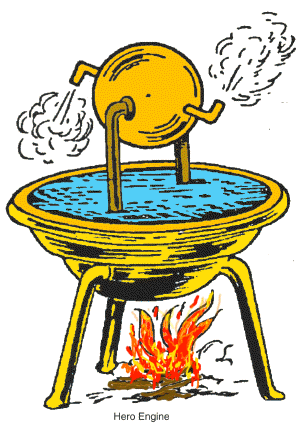
Just when the first true rockets appeared is unclear. Stories of early rocket like devices appear sporadically through the historical records of various cultures. Perhaps the first true rockets were accidents. In the first century A.D., the Chinese were reported to have had a simple form of gunpowder made from saltpeter, sulfur, and charcoal dust. It was used mostly for fireworks in religious and other festive celebrations. Bamboo tubes were filled with the mixture and tossed into fires to create explosions during religious festivals. lt is entirely possible that some of those tubes failed to explode and instead skittered out of the fires, propelled by the gases and sparks produced by the burning gunpowder.

It is certain that the Chinese began to experiment with the gunpowder-filled tubes. At some point, bamboo tubes were attached to arrows and launched with bows. Soon it was discovered that these gunpowder tubes could launch themselves just by the power produced from the escaping gas. The true rocket was born.
The first date we know true rockets were used was the year 1232. At this time, the Chinese and the Mongols were at war with each other. During the battle of Kai-Keng, the Chinese repelled the Mongol invaders by a barrage of "arrows of flying fire." These fire-arrows were a simple form of a solid-propellant rocket. A tube, capped at one end, was filled with gunpowder. The other end was left open and the tube was attached to a long stick. When the powder was ignited, the rapid burning of the powder produced fire, smoke, and gas that escaped out the open end and produced a thrust. The stick acted as a simple guidance system that kept the rocket headed in one general direction as it flew through the air. It is not clear how effective these arrows of flying fire were as weapons of destruction, but their psychological effects on the Mongols must have been formidable.
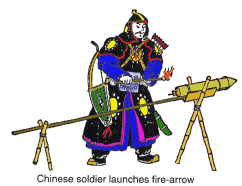
Following the battle of Kai-Keng, the Mongols produced rockets of their own and may have been responsible for the spread of rockets to Europe. All through the 13th to the 15th centuries there were reports of many rocket experiments. In England, a monk named Roger Bacon worked on improved forms of gunpowder that greatly increased the range of rockets. In France, Jean Froissart found that more accurate flights could be achieved by launching rockets through tubes. Froissart's idea was the forerunner of the modern bazooka. Joanes de Fontana of Italy designed a surface-running rocket-powered torpedo for setting enemy ships on fire.
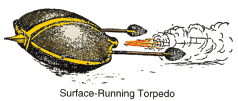
By the 16th century rockets fell into a time of disuse as weapons of war, though they were still used for fireworks displays, and a German fireworks maker, Johann Schmidlap, invented the "step rocket," a multi-staged vehicle for lifting fireworks to higher altitudes. A large sky rocket (first stage) carried a smaller sky rocket (second stage). When the large rocket burned out, the smaller one continued to a higher altitude before showering the sky with glowing cinders. Schmidlap's idea is basic to all rockets today that go into outer space.
Nearly all uses of rockets up to this time were for warfare or fireworks, but there is an interesting old Chinese legend that reported the use of rockets as a means of transportation. With the help of many assistants, a lesser-known Chinese official named Wan-Hu assembled a rocket- powered flying chair. Attached to the chair were two large kites, and fixed to the kites were forty- seven fire-arrow rockets.
On the day of the flight, Wan-Hu sat himself on the chair and gave the command to light the rockets. Forty-seven rocket assistants, each armed with torches, rushed forward to light the fuses. In a moment, there was a tremendous roar accompanied by billowing clouds of smoke. When the smoke cleared, Wan-Hu and his flying chair were gone. No one knows for sure what happened to Wan-Hu, but it is probable that if the event really did take place, Wan-Hu and his chair were blown to pieces. Fire-arrows were as apt to explode as to fly.
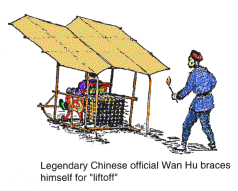
During the latter part of the 17th century, the scientific foundations for modern rocketry were laid by the great English scientist Sir Isaac Newton (1642-1727). Newton organized his understanding of physical motion into three scientific laws. The laws explain how rockets work and why they are able to work in the vacuum of outer space.
Newton's laws soon began to have a practical impact on the design of rockets. About 1720, a Dutch professor, Willem Gravesande, built model cars propelled by jets of steam. Rocket experimenters in Germany and Russia began working with rockets with a mass of more than 45 kilograms. Some of these rockets were so powerful that their escaping exhaust flames bored deep holes in the ground even before lift-off.
During the end of the 18th century and early into the 19th, rockets experienced a brief revival as a weapon of war. The success of Indian rocket barrages against the British in 1792 and again in 1799 caught the interest of an artillery expert, Colonel William Congreve. Congreve set out to design rockets for use by the British military.
The Congreve rockets were highly successful in battle. Used by British ships to pound Fort McHenry in the War of 1812, they inspired Francis Scott Key to write "the rockets' red glare," words in his poem that later became The Star- Spangled Banner.
Even with Congreve's work, the accuracy of rockets still had not improved much from the early days. The devastating nature of war rockets was not their accuracy or power, but their numbers. During a typical siege, thousands of them might be fired at the enemy. All over the world, rocket researchers experimented with ways to improve accuracy. An Englishman, William Hale, developed a technique called spin stabilization. In this method, the escaping exhaust gases struck small vanes at the bottom of the rocket, causing it to spin much as a bullet does in flight. Variations of the principle are still used today.
Rockets continued to be used with success in battles all over the European continent. However, in a war with Prussia, the Austrian rocket brigades met their match against newly designed artillery pieces. Breech-loading cannon with rifled barrels and exploding warheads were far more effective weapons of war than the best rockets. Once again, rockets were relegated to peacetime uses.
In 1898, a Russian schoolteacher, Konstantin Tsiolkovsky (1857-1935), proposed the idea of space exploration by rocket. In a report he published in 1903, Tsiolkovsky suggested the use of liquid propellants for rockets in order to achieve greater range. Tsiolkovsky stated that the speed and range of a rocket were limited only by the exhaust velocity of escaping gases. For his ideas, careful research, and great vision, Tsiolkovsky has been called the father of modern astronautics.
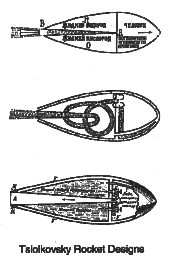
Early in the 20th century, an American, Robert H. Goddard (1882-1945), conducted practical experiments in rocketry. He had become interested in a way of achieving higher altitudes than were possible for lighter-than-air balloons. He published a pamphlet in 1919 entitled A Method of Reaching Extreme Altitudes. It was a mathematical analysis of what is today called the meteorological sounding rocket.
In his pamphlet, Goddard reached several conclusions important to rocketry. From his tests, he stated that a rocket operates with greater efficiency in a vacuum than in air. At the time, most people mistakenly believed that air was needed for a rocket to push against and a New York Times newspaper editorial of the day mocked Goddard's lack of the "basic physics ladled out daily in our high schools." Goddard also stated that multistage or step rockets were the answer to achieving high altitudes and that the velocity needed to escape Earth's gravity could be achieved in this way.
Goddard's earliest experiments were with solid-propellant rockets. In 1915, he began to try various types of solid fuels and to measure the exhaust velocities of the burning gases.
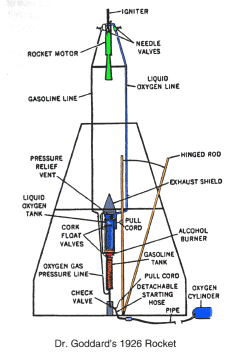
While working on solid-propellant rockets, Goddard became convinced that a rocket could be propelled better by liquid fuel. No one had ever built a successful liquid-propellant rocket before. It was a much more difficult task than building solid- propellant rockets. Fuel and oxygen tanks, turbines, and combustion chambers would be needed. In spite of the difficulties, Goddard achieved the first successful flight with a liquid- propellant rocket on March 16, 1926. Fueled by liquid oxygen and gasoline, the rocket flew for only two and a half seconds, climbed 12.5 meters, and landed 56 meters away in a cabbage patch. By today's standards, the flight was unimpressive, but like the first powered airplane flight by the Wright brothers in 1903, Goddard's gasoline rocket was the forerunner of a whole new era in rocket flight.
Goddard's experiments in liquid-propellant rockets continued for many years. His rockets became bigger and flew higher. He developed a gyroscope system for flight control and a payload compartment for scientific instruments. Parachute recovery systems were employed to return rockets and instruments safely. Goddard, for his achievements, has been called the father of modern rocketry.
A third great space pioneer, Hermann Oberth (1894-1989) of Germany, published a book in 1923 about rocket travel into outer space. His writings were important. Because of them, many small rocket societies sprang up around the world. In Germany, the formation of one such society, the Verein fur Raumschiffahrt (Society for Space Travel), led to the development of the V-2 rocket, which was used against London during World War II. In 1937, German engineers and scientists, including Oberth, assembled in Peenemunde on the shores of the Baltic Sea. There the most advanced rocket of its time would be built and flown under the directorship of Wernher von Braun.
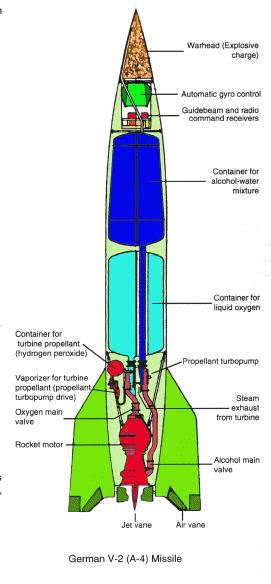
The V-2 rocket (in Germany called the A-4) was small by comparison to today's rockets. It achieved its great thrust by burning a mixture of liquid oxygen and alcohol at a rate of about one ton every seven seconds. Once launched, the V-2 was a formidable weapon that could devastate whole city blocks.
Fortunately for London and the Allied forces, the V-2 came too late in the war to change its outcome. Nevertheless, by war's end, German rocket scientists and engineers had already laid plans for advanced missiles capable of spanning the Atlantic Ocean and landing in the United States. These missiles would have had winged upper stages but very small payload capacities.
With the fall of Germany, many unused V-2 rockets and components were captured by the Allies. Many German rocket scientists came to the United States. Others went to the Soviet Union. The German scientists, including Wernher von Braun, were amazed at the progress Goddard had made.
Both the United States and the Soviet Union realized the potential of rocketry as a military weapon and began a variety of experimental programs. At first, the United States began a program with high-altitude atmospheric sounding rockets, one of Goddard's early ideas. Later, a variety of medium- and long-range intercontinental ballistic missiles were developed. These became the starting point of the U.S. space program. Missiles such as the Redstone, Atlas, and Titan would eventually launch astronauts into space.
On October 4, 1957, the world was stunned by the news of an Earth-orbiting artificial satellite launched by the Soviet Union. Called Sputnik I, the satellite was the first successful entry in a race for space between the two superpower nations. Less than a month later, the Soviets followed with the launch of a satellite carrying a dog named Laika on board. Laika survived in space for seven days before being put to sleep before the oxygen supply ran out.
A few months after the first Sputnik, the United States followed the Soviet Union with a satellite of its own. Explorer I was launched by the U.S. Army on January 31, 1958. In October of that year, the United States formally organized its space program by creating the National Aeronautics and Space Administration (NASA). NASA became a civilian agency with the goal of peaceful exploration of space for the benefit of all humankind.
Soon, many people and machines were being launched into space. Astronauts orbited Earth and landed on the Moon. Robot spacecraft traveled to the planets. Space was suddenly opened up to exploration and commercial exploitation. Satellites enabled scientists to investigate our world, forecast the weather, and to communicate instantaneously around the globe. As the demand for more and larger payloads increased, a wide array of powerful and versatile rockets had to be built.
Since the earliest days of discovery and experimentation, rockets have evolved from
simple gunpowder devices into giant vehicles capable of traveling into outer space.
Rockets have opened the universe to direct exploration by humankind.
Send all comments to ![]() aeromaster@eng.fiu.edu
aeromaster@eng.fiu.edu
© 1995-98 ALLSTAR Network. All rights reserved worldwide.
Updated: February 23, 1999